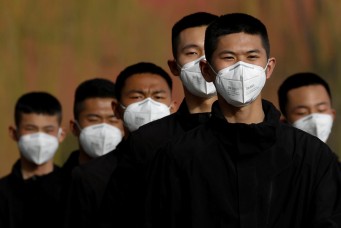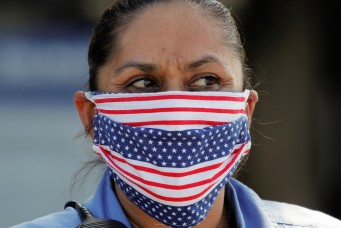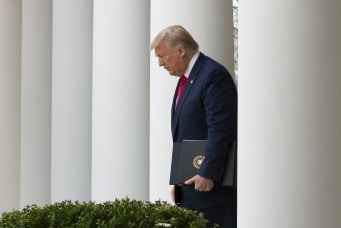The U.S. Pandemic Response: The Challenge of Competing Narratives
The American people lose out to contradictory official messages during a crisis that has been framed within the 2020 presidential election.

U.S. President Donald Trump is accompanied by Vice President Mike Pence and National Institute of Allergy and Infectious Diseases Director Anthony Fauci during the daily coronavirus briefing at the White House in Washington, U.S., March 17, 2020. REUTERS/Jonathan Ernst
The U.S. Centers for Disease Control and Prevention’s (CDC) website on crisis and emergency risk communication states that “The right message at the right time from the right person can save lives.”
In exploring mediated messages from U.S. President Donald Trump and the medical and public health experts during the COVID-19 pandemic, it is clear that there was not always a “right” message, that the “right” person wasn’t always giving it, and that lives may have been lost unnecessarily due to delayed responses to the virus.
The COVID-19 crisis in the United States is unique for multiple reasons, and those reasons create competing narratives throughout the crisis. It can be argued that the occurrence of the virus during a presidential election year with a deep political divide in addition to competing narratives, a federal system, a culture of individual rights, and a capitalist economy all serve to create a disjointed response that impacts risk management.
The Nature of Argument and Source Credibility in Risk Management
Before explaining the current situation in the United States relative to the virus, it is important to provide some underlying theory. Experts and public officials are making arguments to persuade citizens to adjust their behavior to “flatten the curve”: i.e., to spread the number of cases over a longer period to better ensure availability of medical supplies and hospital beds. Argumentation research identifies three spheres of argument: public, technical, and personal. Public sphere arguments are designed to persuade listeners to a given position, often partisan. The technical sphere produces arguments from experts who persuade through data and their own expertise. The personal sphere, as the name suggests, addresses arguments impacting our personal lives. What makes the COVID-19 crisis an especially complex one in the United States is that all three spheres are operating simultaneously, and often with competing narratives. Briefings are not conducted by health experts alone, as is done in many countries, but are shared with the president, who often projects a political agenda and makes comments on medical issues that often contradict the experts.
As arguments are made in the public and technical spheres during a public health crisis, credible sources are essential to sound decision-making and behavioral change. Credibility is also of three types: initial, derived, and terminal. Initial credibility results from a person’s expertise before ever presenting an argument. Thus, the medical experts on the coronavirus task force were chosen for their long-standing experience in dealing with infectious diseases and pandemics. The president, vice-president, cabinet secretaries, governors, and mayors also come to the microphone with credibility as leaders who are charged with ensuring the public good. Through communication via the media, experts derive additional credibility based on the soundness of their data-driven arguments, their language, and their ability to demonstrate empathy for the audience. The combination of perceived and derived credibility culminates in terminal credibility—a persistent trust level at the message’s conclusion that is important for behavioral change.
In crisis situations, experts and political actors are advised to follow several guidelines to mitigate the crisis and retain trust and credibility. The CDC statement at the start of this essay succinctly states some of those guidelines. The challenge in public health crises is in finding the “rights”, especially in a highly charged political environment. Professor Matthew W. Seeger of Wayne State University in Detroit, Michigan, an expert on crisis communication and risk management, summarized the following: honesty; candor; openness; collaboration and coordination with credible sources; communication with compassion, concern, and empathy; accepting uncertainty and ambiguity; and messages of self-efficacy that help individuals know what they can do specifically to reduce risk. The media, as the conduit between experts and the public, serves a vital function in risk management. Although the White House Coronavirus Task Force holds daily televised briefings, many Americans don’t watch every day. They get their summaries from nightly news, newspapers or news sites, and social media. With an entrenched political divide, media outlets with clear political agendas—and a president who tweets daily about fake news—messages intended for risk management have greater potential to miss the mark. This is especially true as individuals seek out information that is consistent with their political philosophies and election year partisanship.
For some, the public and personal spheres play a larger role, frequently through social media, than the technical sphere. To date, however, a large majority of Americans give higher approval ratings to technical sources, especially Dr. Anthony Fauci, the Director of the National Institute of Allergy and Infectious Diseases, than to politicians. Fauci has a 78 percent approval rating compared to Trump’s 46 percent and Congress’ 44 percent. In vanquishing an invisible enemy, however, it only takes one or a few who discount the experts to create a cluster or community spread. Thus, words matter and the coordination among experts, politicians, and media is essential.
A Crisis Mired in Partisan Politics
When pundits and academics have the benefit of time to fully analyze the 2020 COVID-19 crisis in the United States, it will be impossible to do so without framing it within the 2020 presidential election. The fractious political divide in the country led by a highly volatile president known for his scathing tweets, demands for loyalty, and preference for rallies over briefings in addition to an opposition party determined to defeat a president who doesn’t play by their rules is not the ideal scenario for a crisis. As knowledge of a new virus emerged out of China, America was more focused on a crowded Democratic primary, President Trump’s campaign rallies, impeachment proceedings, record-breaking stock values, and low unemployment. President Trump hoped to ride to a second term on the back of economic prosperity—a common reelection formula for a sitting president. The media reported on the virus’ spread, but the reality had not hit U.S. shores until the first travel-related case coming out of Wuhan was announced by the CDC on January 21 in the state of Washington. Reports coming out of Washington increased awareness, but serious public health messaging was not taking place nationwide.
Countless written words and on-air minutes are dedicated to the role of politics and failed leadership in the evolution of the U.S. response to COVID-19. Describing all of the political posturing occurring during the pandemic response would fill several articles. However, the most commonly shared news stories on social media are the timelines researched by the New York Times and The Washington Post. They show that public health experts and Trump advisors were reporting to the president about an impending pandemic, and what Trump was saying to the public was not grounded in the reports. Advisors predicted significant spread with the potential for millions of infections, thousands of deaths, disruption of lives and the economy, and the need for quarantining and social distancing. Trump’s narrative, however, between January 22 and March 11—two days before he declared a national emergency—included the following: “And we have it totally under control”; “It’s going to disappear. One day, it’s like a miracle, it will disappear”; “The Coronavirus is very much under control in the USA. . . .Stock Market starting to look very good to me!”; and “Just stay calm. It will go away.”
Trump and his supporters defend his actions by noting that he announced a travel ban on non-U.S. citizens coming from China on January 31 effective February 2, and that the CDC began screening passengers from Wuhan and imposing quarantines on January 17. Some public health experts called it a band-aid that wouldn’t keep the virus out of the United States because it was spreading beyond China. Over forty thousand authorized travelers entered the United States from China since the ban. At the April 13 briefing, the president was in full campaign mode, showing a three-minute video praising his “early” response and sharing laudatory remarks from some governors. The video was a rebuttal to comments made by Fauci in an appearance on CNN the previous day. Fauci was asked if the country could have saved lives with February rather than March social distancing and stay at home orders. Fauci responded, “. . . you could logically say that if you had a process that was ongoing and you started mitigation earlier, you could have saved lives.”
A Trump supporter and one-time opponent to Nancy Pelosi for a Congressional seat, DeAnna Lorraine, tweeted, “Fauci is now saying that had Trump listened to the medical experts earlier he could’ve saved more lives. Fauci was telling people on February 29 that there was nothing to worry about and that it posed no threat to the U.S. public at large. Time to #FireFauci.” Trump, in retweeting Lorraine’s post, added, “Sorry Fake News, it’s all on tape. I banned China long before people spoke up.”
The Twitter story evoked outrage from both sides and concern from many—even Republicans—that Trump would fire Fauci. The White House responded that Fauci was not fired. At the daily White House briefing, Fauci—an expert in diplomacy after serving during six presidencies—explained that he was responding honestly to a hypothetical and that he and the president were on good terms. He described two direct meetings in March with the president and Dr. Deborah Birx, another task force member, to recommend social distancing. He noted that the President accepted the recommendation and announced fifteen days of social distancing. At a later meeting when Fauci told the president that it was not enough, Trump extended it to thirty days. Thus, Fauci attempted to retain his own credibility by emphasizing his honesty, defending the President’s actions without discussing the specifics of the delayed response, and reassuring the American public that he was on the job with influence. While Trump blustered to his base about reopening the country by Easter and having churches full, his actions actually followed the experts’ recommendations.
Without the president’s visceral reaction to Fauci’s CNN appearance and the published timelines, this drama is unnecessary. The politicization of the crisis briefings and Trump’s desire to maintain a base absent campaign rallies and to boost his declining polling numbers contributed to removing focus on what was important at the briefing: keeping the American people informed about the pandemic and what they need to continue doing to protect themselves. While we in the United States do not have detailed information regarding the political machinations behind other countries’ pandemic responses, it is doubtful that any other country has to balance public health messages with political correctness as defined by a president.
The Challenges of Federalism and Individual Rights
Furthermore, unlike what has happened in other countries, a presidential national emergency declaration did not include a national stay-at-home order. Federalism, through the Tenth Amendment to the U.S. Constitution, gives the states “police power” in emergency situations. The theory is that governors are better suited to determine the best approach to such crises. The amendment originates in the founders’ fears of too strong of a central government after having shed the shackles of King George and Parliament. A system of checks and balances keeps no single person or branch of government from having absolute authority. Thus, stay-at-home orders were issued by state governors and mayors, who have their own public health experts at their sides. While President Trump cannot issue a national order, he can use his daily briefings to encourage all governors to issue such orders: but he hasn’t thus far. Instead, he gave cover to like-minded governors to continue business as normal and simultaneously spared himself the blame of any consequences. In this situation, he supported federalism.
The White House task force provides guidance for public health officials at all levels, and that guidance should follow Seeger’s suggestions for collaboration and coordination of all affected agencies for full effectiveness. But, there is a lack of coordination—many days even between Trump’s statements and those of the experts at the daily briefings, let alone across the states. The state-by-state approach took weeks to implement and as of this writing there are still holdouts, all with Republican governors and mostly with low-density populations. Some larger cities within the states have such orders. Governors are encouraging voluntary social distancing and adoption of other suggested safety procedures, often with an emphasis on personal responsibility to solve the crisis. Governors without orders and those who were late with theirs often used individual liberties and protecting business as their arguments. Florida and Texas, for example, did not close beaches until after spring break crowds left. Again, this is a mixed message to young people who perceived themselves as not in danger but who are often carriers.
The Department of Homeland Security provided guidance to local entities on how to determine what constitutes “essential” businesses or activities; however, state orders interpreted these differently, with some labeling gun shops and any business that sells guns or ammunition as essential. In many states, religious gatherings were not banned, but some were initially limited to no more than fifty with social distancing. Religious leaders in several states defied such orders, and the result has been community spread of COVID-19 in some states. One state that resisted what Governor Kristi L. Noem called a “herd mentality” is South Dakota. Noem defied the restrictions and expressed a belief that individuals, not government, need to decide matters including religious practice, work, and play. On April 13, the media reported that South Dakota is the site of one of the largest virus clusters in the country; three hundred workers at a pork packing plant, which is now closed—a closure which is threatening meat supplies in the country—tested positive for COVID-19. Over six hundred are now part of the cluster. Even with urging from local authorities and health officials, Governor Noem continued to resist a state-wide order and instead had a news briefing to tout the benefits of a yet-to-be-proven treatment drug championed repeatedly by President Trump. The issue of the antimalarial drugs hydroxychloroquine and chloroquine is a classic example of the clash between political and medical narratives. In seeking a quick solution to a growing problem, the president ignored the cautions of medical experts who said that early studies of the above drugs are flawed and that there are serious side effects, including cardiac risks, to use. Trump even falsely claimed Food and Drug Administration (FDA) approval; by citing the FDA, Trump attempted to give technical legitimacy to his argument. Now, federal prisons are reported to be stockpiling the drug, which is also used to treat lupus and rheumatoid arthritis. The stockpile potentially could create shortages for individuals with those conditions. Would more direction from the federal level have prevented 300 new cases or cases from church community spreads? Possibly it would have provided political cover for the South Dakota governor and others from Red states to follow the experts rather than subtly encouraging arguments to the base that Trump also needs. The combination of politics and federalism is proving to be fatal and not in a metaphoric way.
The federal system not only creates problems via competing narratives when states have different rules, but it is also a source of confusion as to where the power lies to reopen the country. In major metropolitan areas that encompass more than one state, such as on the east coast or in a city such as Kansas City (which is in the two states of Kansas and Missouri and five counties), differing policies don’t account for travel across borders. In Kansas City, mayors and officials from the five counties gathered together with approved social distancing to announce stay-at-home orders in light of a lack of such direction from the two states. The State of Kansas followed a few days later with a state order, but Missouri took another six days to do the same. On April 13, President Trump declared that he has “ultimate authority” to override states and open the country to business when his soon-to-be-announced expert council on reopening the economy says it is ready, even while also saying he will listen to the health experts. While Trump was making such claims, governors from California, Washington, and Oregon—where the virus first hit and governors acted quickly—announced a compact to help them phase in reopening. Also on April 13, Governor Andrew Cuomo of New York, who also has daily briefings televised nationally, announced that six states formed a compact to coordinate reopening. Those states—New York, New Jersey, Connecticut, Pennsylvania, Rhode Island and Delaware—have over half of the United States’ confirmed cases and over 60 percent of the total deaths. Governors across the country challenged Trump’s claim of ultimate authority. Given the importance of source credibility, competing claims of authority to reopen the country create confusion for the public and require the media to seek out constitutional experts to help clarify the situation—and they have. This creates another level of clash between the public and technical spheres. Trump backed down on his total authority and “authorized” governors to make the decision on reopening that constitutionally was their authority. Trump announced his council to reopen and gave guidelines for doing so the day after the clash with the governors, suggesting that May or even earlier reopenings were up to governors with his recommendations. Because of the growing frustration with stay-at-home measures, growing jobless numbers, and mixed messages about when it is safe to return to “normal”, protests at state capitols demanding governors to reopen the states are taking place with several more scheduled in the next few days. Trump is even seen by some in the media to be encouraging the protestors, with tweets such as “LIBERATE MICHIGAN!” “LIBERATE VIRGINIA!” and “LIBERATE MINNESOTA!”
How Does It All End?
As of April 17, 2020, confirmed U.S. cases total 686,431 and deaths stand at 35,578, up almost twelve thousand in three days and the highest in the world. Italy and France extended their shelter-in-place orders, China is seeing resurgence in cases, and Russia faces a shortage of hospital beds. Many states are still two or three weeks away from their peak. Even though President Trump backed off of his claims of unlimited constitutional power, he made veiled threats to Democratic governors in a tweet referencing the movie “Mutiny on the Bounty”. He said, “A good old fashioned mutiny every now and then is an exciting and invigorating thing to watch, especially when the mutineers need so much from the Captain.” In the movie, the captain IS the villain. Competing narratives thus will continue, but for the most part, the steady hands of national and state public health officials are being heeded by the majority of Americans even amidst protests. Most governors will fight back on any order to open prematurely.
What the pandemic demonstrates is that the technical sphere can overcome conflicting messages and agendas from the public sphere when personal lives are at stake. Unfortunately, what it has also shown is a fractured political landscape and a leader who wants to be considered a wartime president but who can’t guide the country along a common path and provide encouragement and empathy. He instead shows little concern in his formal pronouncements about the suffering of those with the virus and families who have lost loved ones. He seems more concerned about the Americans who have suffered losses in the stock market than those who have lost low-wage jobs and don’t have health insurance. He is stressing reopening the country when the virus has not yet peaked in many locations. He is more concerned with boosting perceptions of his competence via campaign-like videos presented during briefings that are supposed to update the American people on the crisis. How Trump handles the next two to three months of the crisis may largely determine the outcome at the polls in November. The most recent Gallup poll shows a six-point drop in Trump’s approval rating since mid-March. Despite all of the confusion, the American people are doing what they always do—finding solutions without the government as they sew and distribute masks to overcome shortages, make donations to food banks whose lines have doubled, start clinical trials on vaccines and treatment drugs, open hotels to homeless persons, and find ways every day to help friends, neighbors, and family get through.
Diana Bartelli Carlin is professor emerita of communication and former associate provost for graduate and global education at Saint Louis University, St. Louis, Missouri. Prior to her tenure at Saint Louis, she was a professor of communication studies at the University of Kansas and served as dean of the graduate school and international programs for seven years. Carlin’s research is in political communication with an emphasis on presidential rhetoric, political campaigns and debates, and women in politics. Carlin’s research has appeared in the International Encyclopedia of Political Communication, Handbook of Political Communication Research, American Behavioral Scientist, Argumentation and Advocacy, Rhetoric & Public Affairs, Communication Studies, and Political Communication & Persuasion. She is a co-author of Gender and the American Presidency: Nine Presidential Women and the Barriers They Faced. In March 2020 she served as a Distinguished Visiting Researcher at American University in Cairo.
Read More




